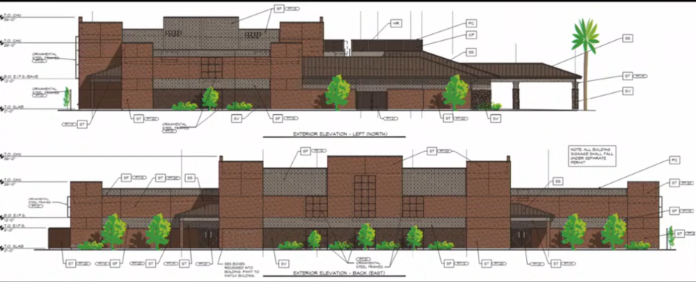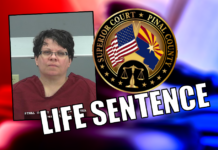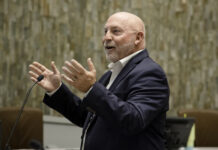
The Planning & Zoning commission on Monday unanimously approved a request by Christ’s Church of the Valley for site, landscape, photometric and elevation-plan approval of its proposed Maricopa campus.
The facility, which will cover 32,800 square feet and be single-story and 36 feet high, is on 10.3 acres in the Seven Ranches district, southeast of Circle K at the southeastern corner of West Honeycutt and North Porter roads.
Christ’s Church of the Valley has 11 campuses around the Valley that are operational or under construction. Founded in 1982 in Peoria, the campuses typically attract about 35,000 worshipers per week to their entire network of campuses.
According to project narrative submitted by CCV, the Maricopa campus will include an auditorium with a capacity of approximately 680. The campus will offer children’s and youth spaces, offices for support staff, kitchen/coffee café, outdoor grill with covered seating area, grass play yard, sport court, fenced athletic fields and parking areas with capacity to support the various events.
CCV Maricopa will have business hours of 8 a.m.-5 p.m., Monday-Thursday. There will be two services on Sunday mornings. Saturday-evening services may be added to accommodate additional demand.
The church’s athletic program, CCV Stars, offers recreational soccer and flag football for children ages 4-14, for eight weeks in both spring and fall. Field lighting will be programmed to shut off at 10 p.m. Monday-Friday. Fields are fenced and not open during off hours.
The site plan calls for four access points: West Honeycutt Road to the north; North Porter Road to the west; and two to the east on West Whisker Road, which will be the back of the facility. The access point on Porter will be quick in-and-out only.
Questions and concerns of commissioners, while few, centered around traffic. Commissioner Jim Irving, in particular, had concern about potential backups on Honeycutt Road.
“You don’t think that’s going to cause a backup on Honeycutt, especially during certain hours?” Irving asked city planner Derek Scheerer. “I guess I’m just envisioning a Porter Road, with our six schools and 3,000 kids that we were told wasn’t going to be a problem.”
The proposed CCV campus sits immediately north of the Sequoia Pathway Academy.
Scheerer said the area at the southern end of Porter that serves the cluster of six schools and the CCV area are vastly different. He emphasized that CCV and the schools will be operating in different time windows, with the church programs on Sunday mornings and, later, Saturday evenings while the schools operate weekdays.
“The church with the schools, they operate at different times,” Scheerer said. “The church is not having people coming at 7 in the morning Monday-Friday. Their events are going to be more in the evening during the week if they are going to have services or have games, there is not going to be a conflict. It’s going to be Friday, Saturday, Sunday use.
“The programs are going to run contrary to the peak times that the high school and the preschool and the other schools, which will be operating during the week, Monday through Friday, 7 a.m. until 3 p.m.”
Commission chair Linda Huggins was skeptical that all activities would be on weekends and evenings.
“CCV is a mega church,” Huggins said. “They are going to be bringing people to this to use the church building, to use this facility, to use these fields. It’s going to be every day, it’s going to be all day. The traffic it’s going to generate is really unknown. And when we have that unknown, it’s really hard to do a traffic study.”
Applicant Paul Warden a member of CCV and its architectural design team, said he does not believe that will be the case.
“In terms of how the church is used, if we can call these satellite churches, the activities are directed by the home church in Peoria,” Warden said. “Our goal is to do less things better rather than a lot of things good. We don’t encourage multiple programs.
“In terms of traffic, we have not had conflicts during the week (at other locations),” Warden continued. “The church is open for staff, and a handful of cars would come on a weekly basis. But this is not designed as a central location or even a regional location. It’s designed as a Maricopa location.”

![3 things to know about the new city budget Vice Mayor Amber Liermann and Councilmember Eric Goettl review parts of the city's 2024 operational budget with Mayor Nancy Smith on April 24, 2024. [Monica D. Spencer]](https://www.inmaricopa.com/wp-content/uploads/2024/04/spencer-042424-preliminary-budget-meeting-web-218x150.jpg)






![MHS G.O.A.T. a ‘rookie sleeper’ in NFL draft Arizona Wildcats wide receiver Jacob Cowing speaks to the press after a practice Aug. 11, 2023. [Bryan Mordt]](https://www.inmaricopa.com/wp-content/uploads/2024/04/cowing-overlay-3-218x150.png)



![Alleged car thief released without charges Phoenix police stop a stolen vehicle on April 20, 2024. [Facebook]](https://www.inmaricopa.com/wp-content/uploads/2024/04/IMG_5040-218x150.jpg)

![3 things to know about the new city budget Vice Mayor Amber Liermann and Councilmember Eric Goettl review parts of the city's 2024 operational budget with Mayor Nancy Smith on April 24, 2024. [Monica D. Spencer]](https://www.inmaricopa.com/wp-content/uploads/2024/04/spencer-042424-preliminary-budget-meeting-web-100x70.jpg)


